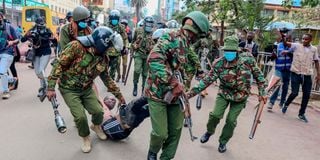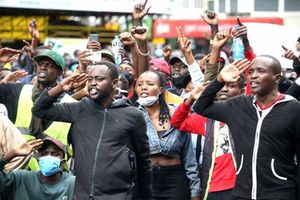
Police officers arrest a protester along Moi Avenue in Nairobi during anti-Finance Bill protests on June 27, 2024.
In its response to the on-going youth revolt, Kenya risks running into the ‘Sudanese trap’ of deepening instability by militarizing politics. In a nutshell, the rising cost of living, deterioration of economic conditions and blatant corruption sparked a series of demonstrations in several Sudanese cities on December 19, 2018.
President Omar al-Bashir responded to these peaceful protests violently by declaring a State of Emergency, dissolving national and regional governments and bringing in the military and the intelligence-service. Quickly, the protests morphed from demands for urgent economic reforms and end to corruption into demands for the President to resign. Eventually, the military overthrew Bashir in a coup d'état on April 11, 2019.
Uncannily, Nairobi appears to be implementing the ‘Sudanese script’ like clockwork. It has used excessive violence and deployed the military to intervene to quell protests by Kenya’s young generation against the 2024 Finance Bill. On June 25, 2024, President William Ruto, through his Defence Cabinet Secretary, issued a gazette notice, deploying the Kenya Defence Forces (KDF) to support the National Police Service (NPS) to restore normalcy after protesters overwhelmed the police, entered and ransacked Parliament and the Supreme Court. The destruction of critical infrastructure, killing of at least 23 and numerous injuries precipitated a profound security emergency across the country.
Occupy State House
This forced President Ruto to withdraw the Finance Bill 2024 on June 26, but the Government immediately called in KDF troops to guard critical or strategic infrastructure after protesters called for a “One Million People March” to occupy the State House in Nairobi on the June 27.
In the past, Kenya has been hailed as a textbook case of a perfect civil-military relation with clear legal contours governed through the National Assembly. This civil-military balance of power is eked into the 2010 Constitution, which sought to put an end to the long history of the heavy-handedness of the military operations deployed to deal with internal security situations. A case in point is the large scale military operation in March 2008 deployed to quell hostilities by the Sabaot Land Defence Force (SLDF) operating in Mount Elgon since 2005.
As such, even as article 241 (3) of the Constitution empowered deployment of military forces to “restore peace in any part of Kenya affected by unrest or instability,” it also added an important caveat. A deployment may “only be made with the approval of the National Assembly.” The Cabinet Secretary has to inform the National Assembly promptly and in appropriate detail for “approval” in line with the Kenya Defence Forces Act (2012) and its 2016 amendment. The result is a system that stress civilian oversight over the military and defines the conduct of the military internally, through the court martial process and externally through the penal process.
Under this legal regime, KDF officers should only be deployed under two scenarios: when there is a situation of emergency or disaster, or to restore peace in any part of Kenya affected by unrest or instability.
Certainly, this is not the first time the KDF has been deployed within Kenya. The military has been deployed to help with rescue operations during emergencies or as part of a multi-agency emergency response. On April 25, Kenya's military was deployed to rescue victims of heavy rains that killed at least 45 people. KDF has also been deployed to conduct an operation in Boni Forest in coastal Kenya to flush out suspected Al Shabaab militia.
But the problem is that the military is trained to kill, not for civilian engagements. Aware of this, Kenyans have remained highly suspicious of the use of the military by the ruling elite. This rings true of the role of the military in the Nairobi Metropolitan Services (NMS) or the Kenya Meat Commission (KMC) under President Uhuru Kenyatta.
Military state
Expectedly, the Gazette Notice has encountered serious headwinds largely because it failed to indicate where, why or for what period KDF was to be deployed. As one opposition legislator aptly remarked, in its current form the deployment regime is effectively turning Kenya into “a military state.” After all, the situation in Kenya is not a conflict but a civil process. Under close scrutiny, the open-ended deployment carries the ugly birthmarks of a “self-coup”, defined by scholars as a form of coup d'état in which a nation’s head, having come to power through legal means, tries to stay in power through illegal means.
The Law Society of Kenya decried the deployment as unconstitutional. It sued the Cabinet Secretary and the National Assembly. A blanket deployment without defining the scope of operation and the duration of KDF operation would likely silence civilian populations exercising their democratic rights, risked driving a wedge between civilians and the forces and militarizing the country.
The CS should have notified the National Assembly for a stamp of approval and a state of emergency declared so that the KDF could be deployed to protect critical government infrastructure and restore order. Although the CS finally sought Parliamentary approval on June 26, 2024, the deployment should have been gazetted 24 hours after parliament's approval.
Kenya's High Court approved the use of military force to quell protests and restore order On June 28. It deemed the deployment critical to protect government installations. However, the court ordered the Government to gazette within two days the terms of the deployment, clarifying how long it would last and the rules of engagement.
Sustainable security requires that Kenya focus on strengthening the capabilities of its paramilitary force, the General Service Unit (GSU), rather than drawing the military into the civilian space. This is the police wing with “certain military characteristics and an appreciable degree of military capabilities but is not part of the armed forces.
Further, taming what is unfolding as ‘the Gen Z Revolution’ requires an ‘intelligence-led’ whole-of-government approach, necessitating a well-oiled and efficient National Intelligence Service (NIS). Acting effectively on citizens’ democratic aspirations is what Kenya needs to drain the swamp of youth radicalization and avert the perilous militarization of politics.
Professor Peter Kagwanja is former Government Adviser and currently the Chief Executive at the Africa Policy Institute









